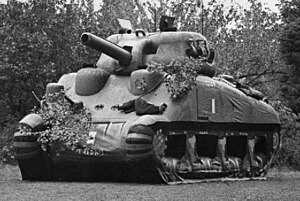Contents[hide] |
History and deployment [edit]
Inspiration for the unit came from the British units who had honed the deception technique for the battle of El Alamein. The U.S unit had its beginnings at Camp Forrest, Tennessee, and was fully formed at Pine Camp, NY (now Fort Drum), before sailing for the United Kingdom in early May 1944. In Britain they were based near Stratford upon Avon, and troops participated in Operation Fortitude, the British designed and led D-Day deception of a landing force designated for the Pas-de-Calais. Which should be noted for U.S intially ridiculing the notion.Some troops went to Normandy two weeks after D-Day, where they simulated a fake Mulberry harbour at night with lights to draw German fire away from the real ones. Next the full force assisted in bottling up the German defenders of Brest by simulating a larger force than was actually encircling them.
As the Allied armies moved east, so did the 23rd, and it eventually was based within Luxembourg, from where it engaged in deceptions of crossings of the Ruhr river, positions along the Maginot Line, Hürtgen Forest, and finally a major crossing of the Rhine to draw German troops away from the actual sites.
Recruiting [edit]
Ghost soldiers were encouraged to use their brains and talent to mislead, deceive and befuddle the German Army. Many were recruited fromAlthough the 23rd Headquarters Special Troops consisted of only 1,100 soldiers, the contingent used equipment pioneered by British forces such as dummy tanks and artillery, fake aircraft and giant speakers broadcasting the sounds of men and artillery to make the Germans think it was upwards of a two-division 30,000 man force. The unit's elaborate ruses helped deflect German units from the locations of larger allied combat units.
The unit consisted of the 406th Combat Engineers (which handled security), the 603rd Camouflage Engineers, the 3132 Signal Service Company Special and the Signal Company Special.
Tactics [edit]
Visual deception [edit]
Sonic deception [edit]
The 3132 Signal Service Company Special handled sonic deception. The unit coalesced under the direction of Colonel Hilton Railey, a colorful figure who, before the war, had “discovered” Amelia Earhart and sent her on her road to fame.Aided by engineers from Bell Labs, a team from the 3132 went to Fort Knox to record sounds of armored and infantry units onto a series of sound effects records that they brought to Europe. For each deception, sounds could be “mixed” to match the scenario they wanted the enemy to believe. This program was recorded on state-of-the-art wire recorders (the predecessor to the tape recorder), and then played back with powerful amplifiers and speakers mounted on halftracks. The sounds they played could be heard 15 miles (24 km) away.[citation needed]
Radio deception [edit]
"Spoof radio", as it was called, was handled by the Signal Company Special. Operators created phony traffic nets, impersonating the radio operators from real units. They learned the art of mimicking a departing operator’s method of sending Morse Code so that the enemy would never detect that the real unit and its radio operator were long gone.Atmosphere [edit]
To add to the mix of techniques, the unit often employed theatrical effects to supplement the other deceptions. Collectively called "atmosphere", this included simulating actual units deployed elsewhere by sewing on their divisional patches, painting appropriate unit designators on vehicles and having the companies deployed as if they were regimental headquarters units. Trucks would be driven in looping convoys with just two troops in the seats near the tailgate, to simulate a truck full of infantry under the canvas cover. "MP's" would be deployed at cross roads wearing appropriate divisional insignia and some officers would simulate divisional generals and staff officers visiting towns where enemy agents were likely to see them. A few actual tanks and artillery pieces were occasionally assigned to the unit to make the dummies in the distance seem more realistic.References [edit]
- ^ Garber, Megan (May 22, 2013). "Ghost Army: The Inflatable Tanks That Fooled Hitler". The Atlantic. Retrieved May 23, 2013.
- ^ Binkovitz, Leah (May 21, 2013). "When an Army of Artists Fooled Hitler". Smithsonian.com. Retrieved May 23, 2013.
- ^ "Exhibit and film celebrate World War II's Ghost Army". The Boston Globe. 2012-02-23. Retrieved 2012-09-06.
- Holley, Joe. (2006, July 8). Louis Dalton Porter; Used Artistic Skills to Trick German Army. The Washington Post, p. B6
- NPR: Artists of Battlefield Deception: Soldiers of the 23rd
- National Army Security Agency Association
- Ghosts of the ETO by John Gawne
- Bare Blass by Bill Blass edited by Cathy Horyn
- Secret Soldiers by Philip Gerard.

No comments:
Post a Comment